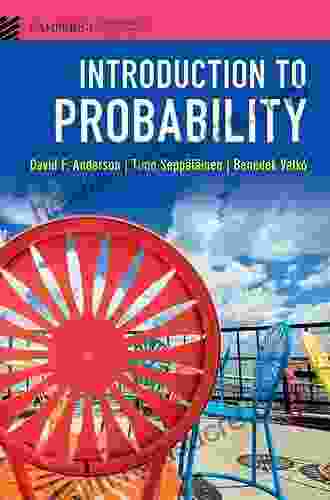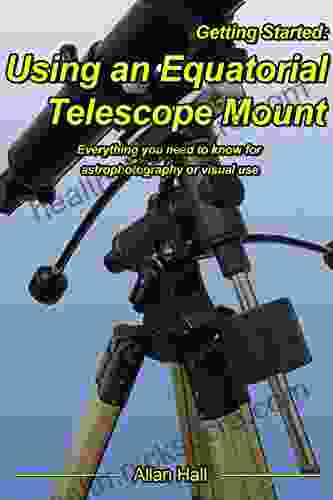Astrophotography and Visual Use: Everything You Need to Know

Astrophotography and visual use of telescopes are two distinct but related fields of astronomy. Astrophotography is the art and science of photographing celestial objects, while visual use involves observing celestial objects with the naked eye or through a telescope. Both activities require an understanding of the night sky and the principles of optics, but they also have their own unique challenges and rewards.
4.4 out of 5
| Language | : | English |
| File size | : | 731 KB |
| Text-to-Speech | : | Enabled |
| Screen Reader | : | Supported |
| Enhanced typesetting | : | Enabled |
| Word Wise | : | Enabled |
| Print length | : | 71 pages |
| Lending | : | Enabled |
Equipment for Astrophotography
The most important piece of equipment for astrophotography is a telescope. The type of telescope you need will depend on the type of astrophotography you want to do. For deep-sky astrophotography, you will need a telescope with a large aperture (diameter) and a long focal length. For planetary astrophotography, you will need a telescope with a shorter focal length and a smaller aperture.
In addition to a telescope, you will also need a camera. DSLR cameras are the most popular choice for astrophotography, as they offer a good balance of price, performance, and features. You will also need a tripod to mount your camera and telescope on, and a variety of filters to help you capture the best possible images.
Equipment for Visual Use
For visual use, you will need a telescope that is appropriate for the type of observing you want to do. If you are interested in observing deep-sky objects, you will need a telescope with a large aperture. If you are interested in observing planets, you will need a telescope with a shorter focal length.
In addition to a telescope, you will also need a few other accessories for visual use. These accessories include:
- Eyepieces: Eyepieces magnify the image produced by the telescope, and they come in a variety of focal lengths. The focal length of an eyepiece is measured in millimeters, and it determines the magnification of the image. A shorter focal length eyepiece will produce a higher magnification, while a longer focal length eyepiece will produce a lower magnification.
- Finderscope: A finderscope is a small telescope that is mounted on the main telescope. It is used to help you find and center the objects you want to observe.
- Star chart: A star chart is a map of the night sky. It is used to help you identify the objects you are observing.
Techniques for Astrophotography
There are a number of different techniques that you can use to capture great astrophotography images. Some of the most important techniques include:
- Long exposures: Long exposures are essential for capturing faint objects in the night sky. To capture a long exposure, you will need to use a tripod to stabilize your camera and telescope. You will also need to use a shutter release to avoid shaking the camera when you take the picture.
- Stacking: Stacking is a technique that involves taking multiple images of the same object and then combining them into a single image. This technique can help to reduce noise and improve the signal-to-noise ratio of your images.
- Post-processing: Post-processing is the process of editing your astrophotography images to improve their appearance. This can involve adjusting the brightness and contrast, removing noise, and cropping the image.
Techniques for Visual Use
There are a number of different techniques that you can use to improve your visual observations of celestial objects. Some of the most important techniques include:
- Dark adaptation: Dark adaptation is the process of allowing your eyes to adjust to the darkness. This can take up to 30 minutes, so it is important to be patient. Once your eyes are dark adapted, you will be able to see fainter objects.
- Averted vision: Averted vision is a technique that involves looking slightly to the side of the object you are observing. This can help to improve your sensitivity to faint objects.
- Filters: Filters can be used to improve the contrast of certain objects in the night sky. For example, a light pollution filter can be used to reduce the effects of light pollution from cities and towns.
Considerations for Astrophotography
There are a number of different factors that you need to consider when ng astrophotography. These factors include:
- Weather: The weather can have a significant impact on your ability to do astrophotography. Clear skies are essential for capturing good images, so it is important to check the weather forecast before you head out to do astrophotography.
- Light pollution: Light pollution can also have a negative impact on astrophotography. Light pollution can make it difficult to see faint objects, and it can also cause your images to be washed out. If you live in a light-polluted area, you will need to find a dark sky site to do astrophotography.
- Equipment: The equipment you use will also have a significant impact on the quality of your astrophotography images. It is important to choose the right equipment for the type of astrophotography you want to do, and to learn how to use it properly.
Considerations for Visual Use
There are a number of different factors that you need to consider when ng visual observing. These factors include:
- Seeing conditions: Seeing conditions refer to the steadiness of the atmosphere. Good seeing conditions are essential for high-quality visual observations. Poor seeing conditions can make it difficult to see faint objects, and they can also cause stars to appear to twinkle.
- Transparency: Transparency refers to the amount of moisture and dust in the atmosphere. Good transparency is essential for high-quality visual observations. Poor transparency can make it difficult to see faint objects, and it can also cause the stars to appear to be dimmer.
- Equipment: The equipment you use will also have a significant impact on the quality of your visual observations. It is important to choose the right equipment for the type of observing you want to do, and to learn how to use it properly.
Astrophotography and visual use of telescopes are both rewarding activities that can provide you with a deeper understanding of the night sky. By following the tips and advice in this article, you can improve the quality of your astrophotography images and your visual observations.
4.4 out of 5
| Language | : | English |
| File size | : | 731 KB |
| Text-to-Speech | : | Enabled |
| Screen Reader | : | Supported |
| Enhanced typesetting | : | Enabled |
| Word Wise | : | Enabled |
| Print length | : | 71 pages |
| Lending | : | Enabled |
Do you want to contribute by writing guest posts on this blog?
Please contact us and send us a resume of previous articles that you have written.
 Fiction
Fiction Non Fiction
Non Fiction Romance
Romance Mystery
Mystery Thriller
Thriller SciFi
SciFi Fantasy
Fantasy Horror
Horror Biography
Biography Selfhelp
Selfhelp Business
Business History
History Classics
Classics Poetry
Poetry Childrens
Childrens Young Adult
Young Adult Educational
Educational Cooking
Cooking Travel
Travel Lifestyle
Lifestyle Spirituality
Spirituality Health
Health Fitness
Fitness Technology
Technology Science
Science Arts
Arts Crafts
Crafts DIY
DIY Gardening
Gardening Petcare
Petcare Marianne Williamson
Marianne Williamson David Hurst Thomas
David Hurst Thomas John Novosel Jr
John Novosel Jr Saint Teresa Of Avila
Saint Teresa Of Avila Sportsman S Connection
Sportsman S Connection Elliot Aronson
Elliot Aronson Mark Beauregard
Mark Beauregard Dennis Overbye
Dennis Overbye John Bargh Ph D
John Bargh Ph D Maria Rickert Hong
Maria Rickert Hong S Allen Counter
S Allen Counter Jeff Brent
Jeff Brent Chris Lundgren
Chris Lundgren Tress Bowen
Tress Bowen Amy Saltzman
Amy Saltzman Valerie Gilpeer
Valerie Gilpeer Douglas Whynott
Douglas Whynott Konnie Wong
Konnie Wong Roy Shepard
Roy Shepard Stuart Holmes Coleman
Stuart Holmes Coleman Alisha J Brown
Alisha J Brown Chris Cannon
Chris Cannon John Michael Kelly
John Michael Kelly Richard H Thaler
Richard H Thaler Allison Williams
Allison Williams Kaitlyn Hill
Kaitlyn Hill Thomas R Verny
Thomas R Verny Meredith L Jacobs
Meredith L Jacobs Jean Jacques Chevron
Jean Jacques Chevron Kim Heacox
Kim Heacox Brian Treanor
Brian Treanor Milton Gussow
Milton Gussow Rex Allen Jones Ii
Rex Allen Jones Ii Annabeth Headrick
Annabeth Headrick Karen Murphy
Karen Murphy Iain Gately
Iain Gately Alison Scott Wright
Alison Scott Wright Karen Blumenthal
Karen Blumenthal Linda S Jones
Linda S Jones Allen J Christenson
Allen J Christenson Deborah Ann Davis
Deborah Ann Davis Leah Vanderveldt
Leah Vanderveldt Judith Mckay
Judith Mckay Jimena Canales
Jimena Canales Marc Vachon
Marc Vachon Sid Roth
Sid Roth Henry Cloud
Henry Cloud Stephen Haddelsey
Stephen Haddelsey Daniel J Levitin
Daniel J Levitin Michael Shermer
Michael Shermer Carla Simpson
Carla Simpson Philip Gosse
Philip Gosse Allen Morris Jones
Allen Morris Jones Beth Cavenaugh
Beth Cavenaugh Jacqueline H Wolf
Jacqueline H Wolf Allen O Bannon
Allen O Bannon Nikki Solano
Nikki Solano Leonard Shlain
Leonard Shlain Liz Clark
Liz Clark Dr Danielle Ward
Dr Danielle Ward 10th Edition Kindle Edition
10th Edition Kindle Edition Jeff Gordon
Jeff Gordon Don Miguel Ruiz
Don Miguel Ruiz Peggy L Chinn
Peggy L Chinn David Eagleman
David Eagleman Chris Chambers
Chris Chambers Charlotte Runcie
Charlotte Runcie Grace E Stewart
Grace E Stewart Ronald Hutton
Ronald Hutton D C Fergerson
D C Fergerson Priya Ardis
Priya Ardis Molly Forbes
Molly Forbes Christina Hoff Sommers
Christina Hoff Sommers Barbara De Angelis
Barbara De Angelis James Patterson
James Patterson John Shewey
John Shewey Stephen E Flowers
Stephen E Flowers Eric Newby
Eric Newby Jonathan Moeller
Jonathan Moeller Alison Gervais
Alison Gervais Claude Levi Strauss
Claude Levi Strauss Mourad Boufadene
Mourad Boufadene Judith Rich Harris
Judith Rich Harris Jim Cheney
Jim Cheney Mark Dice
Mark Dice Brian Lopes
Brian Lopes Allison Arevalo
Allison Arevalo Pottermore Publishing
Pottermore Publishing Bill Hendricks
Bill Hendricks David M Killoran
David M Killoran Mary Elizabeth O Brien
Mary Elizabeth O Brien Rob Shelsky
Rob Shelsky Anil Seth
Anil Seth Sean Patrick
Sean Patrick Gerd Gigerenzer
Gerd Gigerenzer Clive Cussler
Clive Cussler Jack Smith
Jack Smith Joel Thomas Chopp
Joel Thomas Chopp William B Helmreich
William B Helmreich Alistair Cooke
Alistair Cooke Matthew Mccoy
Matthew Mccoy Maria Thompson Daviess
Maria Thompson Daviess Kenneth Igiri
Kenneth Igiri Toru Toba
Toru Toba Joe Kelly
Joe Kelly Norrinda Brown Hayat
Norrinda Brown Hayat Mandi Hickman
Mandi Hickman Dave Pelz
Dave Pelz Rebecca St James
Rebecca St James Allison Tyson
Allison Tyson Kimberly Brown
Kimberly Brown Diana Korte
Diana Korte W E Fairbairn
W E Fairbairn Jim C Hines
Jim C Hines Suzanne Nottingham
Suzanne Nottingham Allan Trevor
Allan Trevor Sheena Byrom
Sheena Byrom Roy Macskimming
Roy Macskimming Rhonda Huettenmueller
Rhonda Huettenmueller Tom Watson
Tom Watson Jim Mancuso
Jim Mancuso William A Haviland
William A Haviland Alivia Stephens
Alivia Stephens Neil Hayes
Neil Hayes Sarah P Morris
Sarah P Morris Eickhel Mendoza
Eickhel Mendoza Segun Adebajo
Segun Adebajo Lynn Stafford Yilmaz
Lynn Stafford Yilmaz John Bul Dau
John Bul Dau Cate Stillman
Cate Stillman William W Dressler
William W Dressler John C Lennox
John C Lennox Walter Isaacson
Walter Isaacson Perry Lefko
Perry Lefko Bret Hart
Bret Hart Tim Hodkinson
Tim Hodkinson Jonathan St B T Evans
Jonathan St B T Evans Paul Schullery
Paul Schullery C Calvin Jones
C Calvin Jones Aly Raisman
Aly Raisman Danica G Hays
Danica G Hays Courtney Summers
Courtney Summers Frank Delaney
Frank Delaney Carl Paoli
Carl Paoli Allen M Hornblum
Allen M Hornblum Sam Jefferson
Sam Jefferson Karen Bonnell
Karen Bonnell Neely Spence Gracey
Neely Spence Gracey Victor Canning
Victor Canning Allan Kardec
Allan Kardec Tim Rappleye
Tim Rappleye Dennis Jarecke
Dennis Jarecke Eric Naguski
Eric Naguski Rex L Forehand
Rex L Forehand Richard Kaczynski
Richard Kaczynski Selene Yeager
Selene Yeager Grant S Lipman
Grant S Lipman Roger Bannister
Roger Bannister Andrew Kastor
Andrew Kastor Laura Randall
Laura Randall Anna Leinberger
Anna Leinberger Holly Homer
Holly Homer Paul D Brinkman
Paul D Brinkman Phil Hornshaw
Phil Hornshaw Allan G Bluman
Allan G Bluman Lionel Cruzille
Lionel Cruzille The Dark Lords
The Dark Lords L H Nicole
L H Nicole Bobby Clampett
Bobby Clampett George Buehler
George Buehler Marti Olsen Laney
Marti Olsen Laney Kevin Leman
Kevin Leman Nevin Martell
Nevin Martell Tom Kelly
Tom Kelly Susan Neiman
Susan Neiman Lisa Marshall
Lisa Marshall Laerke Recht
Laerke Recht Greg Henry
Greg Henry Gregory Cochran
Gregory Cochran Jeffrey E Young
Jeffrey E Young Tim Roughgarden
Tim Roughgarden Ryan Hall
Ryan Hall Joe Sparrow
Joe Sparrow Gail Steketee
Gail Steketee Meritxell Castells
Meritxell Castells J Richard Gott
J Richard Gott Alexandra Amor
Alexandra Amor Naomi Kokoricha
Naomi Kokoricha W Edwards Deming
W Edwards Deming James Kipling
James Kipling Kathleen Bachynski
Kathleen Bachynski Kelsey Banfield
Kelsey Banfield Natasha Devon
Natasha Devon Ed Robinson
Ed Robinson Lexie Scott
Lexie Scott Dan Miller
Dan Miller Giuseppe Mascoli
Giuseppe Mascoli Jennifer Louden
Jennifer Louden Michael Reist
Michael Reist Maria Hannay
Maria Hannay Aliza Kelly
Aliza Kelly Novak Djokovic
Novak Djokovic Rodney Ford
Rodney Ford Peter Mark Adams
Peter Mark Adams Sarah Grison
Sarah Grison Julie Currin
Julie Currin Don Harris
Don Harris Michael Fullan
Michael Fullan Lisa M Rose
Lisa M Rose Allen R Angel
Allen R Angel Daniel J Siegel
Daniel J Siegel Jason Durham
Jason Durham Sharon Weinberger
Sharon Weinberger James Sieckmann
James Sieckmann Elce Junior Lauriston
Elce Junior Lauriston Randy Olson
Randy Olson Sabatino Moscati
Sabatino Moscati Justin J Exner
Justin J Exner Kim Liggett
Kim Liggett Bruce Tremper
Bruce Tremper Lsatmax Lsat Prep
Lsatmax Lsat Prep Petr Zima
Petr Zima Stuart A Kauffman
Stuart A Kauffman Michelle Nijhuis
Michelle Nijhuis James Fallows
James Fallows Douglas Nicholas
Douglas Nicholas Kenji Tokitsu
Kenji Tokitsu Meredith Russo
Meredith Russo Robert S Witte
Robert S Witte Chris Mulder
Chris Mulder Tiger Woods
Tiger Woods Charles J Robinson
Charles J Robinson Greg Strandberg
Greg Strandberg Paul J Kosmin
Paul J Kosmin Shobi Nolan
Shobi Nolan Cinda Williams Chima
Cinda Williams Chima John Lloyd
John Lloyd Robert Penn Warren
Robert Penn Warren Peter Van Der Linden
Peter Van Der Linden Dan Abrahams
Dan Abrahams Julie Morgenstern
Julie Morgenstern Susan Kuklin
Susan Kuklin Liz Evers
Liz Evers Ashley D Kendall
Ashley D Kendall Signe Pike
Signe Pike Bryan Goodwin
Bryan Goodwin Kwame Onwuachi
Kwame Onwuachi Cy Tymony
Cy Tymony Tami Overhauser
Tami Overhauser Joe Kenn
Joe Kenn Kara Lawrence
Kara Lawrence Jared Cohen
Jared Cohen Allan Hall
Allan Hall Paul Green
Paul Green Arthur Aughey
Arthur Aughey Edmund Richardson
Edmund Richardson Milt Rosko
Milt Rosko Marc Bubbs
Marc Bubbs Christopher Bruhn
Christopher Bruhn James F Mckenzie
James F Mckenzie Scott Smith
Scott Smith Rowena Murray
Rowena Murray Kevin West
Kevin West Helen Macdonald
Helen Macdonald P Schreiber
P Schreiber Jennifer Waldburger
Jennifer Waldburger Bill Horn
Bill Horn Matthew Syed
Matthew Syed Dr Fiona Mcpherson
Dr Fiona Mcpherson Vincent Schilling
Vincent Schilling Ben Greenfield
Ben Greenfield Allen Everett
Allen Everett Bright Summaries
Bright Summaries Steve J Martin
Steve J Martin Carrot Quinn
Carrot Quinn Pamela Douglas
Pamela Douglas Annie F Downs
Annie F Downs Debra L Martin
Debra L Martin Aubrey Gordon
Aubrey Gordon Theodore B Sauselein
Theodore B Sauselein Amy Wenzel
Amy Wenzel Ken Cohen
Ken Cohen Kota Nozomi
Kota Nozomi Jdmission Senior Consultants
Jdmission Senior Consultants Raymond Turner
Raymond Turner Rick Johnson
Rick Johnson Alison Aulakh
Alison Aulakh Nick Karas
Nick Karas George M Johnson
George M Johnson Tom Daley
Tom Daley Mark Kistler
Mark Kistler James Ferguson
James Ferguson Robin Stevenson
Robin Stevenson John Kavanagh
John Kavanagh Allen Carr
Allen Carr Emma Shelford
Emma Shelford Myrna Blyth
Myrna Blyth Daniel Mendelsohn
Daniel Mendelsohn Marlin M Mackenzie
Marlin M Mackenzie Geoff Salmon
Geoff Salmon Pure Calisthenics
Pure Calisthenics Matthieu Auzanneau
Matthieu Auzanneau Eddie Guerrero
Eddie Guerrero Susan Ware
Susan Ware David F Anderson
David F Anderson Arianna Brooks
Arianna Brooks Jennifer E Smith
Jennifer E Smith Robert M Sapolsky
Robert M Sapolsky Allen N Mendler
Allen N Mendler Eli Saslow
Eli Saslow Debi Pearl
Debi Pearl John Hughes
John Hughes Joanna Foley Rd
Joanna Foley Rd P J Richards
P J Richards Grace Lindsay
Grace Lindsay Jeremy Evans
Jeremy Evans Jim Rahtz
Jim Rahtz Carlo Ancelotti
Carlo Ancelotti Dan Millman
Dan Millman Giancarlo Lemmi
Giancarlo Lemmi Patrick Stewart
Patrick Stewart Jeff Burlingame
Jeff Burlingame Stephen R Covey
Stephen R Covey Godfrey Higgins
Godfrey Higgins Jason Padgett
Jason Padgett Muthukumaran Mani
Muthukumaran Mani Richard M Van Gaasbeek
Richard M Van Gaasbeek Alina A Von Davier
Alina A Von Davier Mary Bergin
Mary Bergin Felix Marks
Felix Marks Kaylee Cole
Kaylee Cole Itzik Ben Gan
Itzik Ben Gan Alistair Higham
Alistair Higham Wendelin Van Draanen
Wendelin Van Draanen Karen Wambach
Karen Wambach Lynn Rush
Lynn Rush Vitalis I Valentine
Vitalis I Valentine Chris Fox
Chris Fox Roy Clark
Roy Clark Jorge Muniz
Jorge Muniz Lennard Bickel
Lennard Bickel Andrie De Vries
Andrie De Vries Jay Blahnik
Jay Blahnik Frederick Courteney Selous
Frederick Courteney Selous Jenara Nerenberg
Jenara Nerenberg Dr Nadine Sinclair
Dr Nadine Sinclair Somaiya Daud
Somaiya Daud Erica Abbett
Erica Abbett Alicia F Lieberman
Alicia F Lieberman Joseph Fort Newton
Joseph Fort Newton Nick Riley
Nick Riley Ethem Mining
Ethem Mining Greg Moran
Greg Moran Suzanne Alderson
Suzanne Alderson Mian Majid Ali Afzal
Mian Majid Ali Afzal Travis Jeffery
Travis Jeffery Hilda Jarman Muir
Hilda Jarman Muir Christian Asonye
Christian Asonye Franz Kellermann
Franz Kellermann Ron Merly
Ron Merly Tami Asars
Tami Asars Allan Phillips
Allan Phillips Robin Riley
Robin Riley Pass Your Class
Pass Your Class Joe Vasicek
Joe Vasicek Ryan Spaeder
Ryan Spaeder Harald B Teicher
Harald B Teicher Ann C Logue
Ann C Logue Alister E Mcgrath
Alister E Mcgrath Jim Downs
Jim Downs Eugen Herrigel
Eugen Herrigel Brett Lee Scott
Brett Lee Scott Alison Palmer
Alison Palmer N B Hankes
N B Hankes Winston Churchill
Winston Churchill Judy Converse
Judy Converse Robert Green
Robert Green Alicia Jasinska
Alicia Jasinska Michaelbrent Collings
Michaelbrent Collings Rene Almeling
Rene Almeling Chris Lear
Chris Lear Mark F Sohn
Mark F Sohn Allen Dulles
Allen Dulles Edmund G R Kraal
Edmund G R Kraal J R R Tolkien
J R R Tolkien Robert Taylor
Robert Taylor Allison Alexy
Allison Alexy Joel S Owen
Joel S Owen Noor Ain
Noor Ain David Hancock
David Hancock Daniel Stewart
Daniel Stewart Allison Dolan
Allison Dolan Lynn Acton
Lynn Acton Amby Burfoot
Amby Burfoot Pasco Valana
Pasco Valana Anna Costaras
Anna Costaras Simone Milasas
Simone Milasas Alistair Brownlee
Alistair Brownlee Linda Greenlaw
Linda Greenlaw Scott Graham
Scott Graham Deborah Macnamara Phd
Deborah Macnamara Phd Mike Zimmerman
Mike Zimmerman Dennis Georgatos
Dennis Georgatos Matt Hart
Matt Hart Joshua Elliot James
Joshua Elliot James Linda Barrett Osborne
Linda Barrett Osborne Gary Sizer
Gary Sizer Linda A Curtis
Linda A Curtis Edwin Amenta
Edwin Amenta Rachel Caine
Rachel Caine Etienne Noumen
Etienne Noumen Allistair Mccaw
Allistair Mccaw Lewis Carroll
Lewis Carroll Alison Pearlman
Alison Pearlman Linda Martella Whitsett
Linda Martella Whitsett Randy Russell
Randy Russell Jeff Hawkins
Jeff Hawkins Despina Meris
Despina Meris Allison Norfolk
Allison Norfolk Jim Bell
Jim Bell Ronald E Mickens
Ronald E Mickens Kate Wood
Kate Wood Casi Mclean
Casi Mclean Janet E Wall
Janet E Wall Allen Stroud
Allen Stroud Ian Westermann
Ian Westermann Alexander Clarke
Alexander Clarke Allison Mcdonald Ace
Allison Mcdonald Ace Andrew Benfield
Andrew Benfield Jon S Bailey
Jon S Bailey William Stott
William Stott Steven J Burton
Steven J Burton Alison Lighthall Miller
Alison Lighthall Miller Josephine Perry
Josephine Perry Charles Conn
Charles Conn Shawn D Madden
Shawn D Madden Robbin Gregory
Robbin Gregory Kate Mcmahon
Kate Mcmahon Alan Watts
Alan Watts Mary Quinlan Mcgrath
Mary Quinlan Mcgrath Jonathan E Steinhart
Jonathan E Steinhart Dr Ron M Horner
Dr Ron M Horner Carla Mooney
Carla Mooney Olajumoke Adenowo
Olajumoke Adenowo Joseph Harkreader
Joseph Harkreader Bill Varney Jr
Bill Varney Jr Mara Krechevsky
Mara Krechevsky Kate Clifford Larson
Kate Clifford Larson Allison Schrager
Allison Schrager Grant Petersen
Grant Petersen Emily Thiede
Emily Thiede Kristine Hudson
Kristine Hudson Brenda Boyd
Brenda Boyd Carolyn Shearlock
Carolyn Shearlock Jen Torborg
Jen Torborg Y R Davis
Y R Davis Maurice Isserman
Maurice Isserman Gary Leland
Gary Leland Gavin Fairbairn
Gavin Fairbairn The Editors Of Outside Magazine
The Editors Of Outside Magazine Sylvia Larsen
Sylvia Larsen Glenn Tinnin
Glenn Tinnin Monique Joiner Siedlak
Monique Joiner Siedlak Trae Dorn
Trae Dorn Chip Coffey
Chip Coffey Suzanne O Sullivan
Suzanne O Sullivan Raychelle Cassada Lohmann
Raychelle Cassada Lohmann Joosr
Joosr Tim Baker
Tim Baker Vivian Gornick
Vivian Gornick Lydia Sherrer
Lydia Sherrer John Macinnes
John Macinnes Emily Parke Chase
Emily Parke Chase Bogdan Ivanov
Bogdan Ivanov Eric Lemarque
Eric Lemarque Jim Cobb
Jim Cobb Tom Babin
Tom Babin Paul S Auerbach
Paul S Auerbach Frank Christianson
Frank Christianson Michele Stanten
Michele Stanten Allan House
Allan House Robert Kiltz
Robert Kiltz Marie Osmond
Marie Osmond Fluent In Korean
Fluent In Korean Apryl Baker
Apryl Baker Teri Moser Woo
Teri Moser Woo Brenda Gable
Brenda Gable C S Wilde
C S Wilde Brian Boone
Brian Boone Julie Schwietert
Julie Schwietert Catherine Gildiner
Catherine Gildiner Peter Hollins
Peter Hollins The School Of Life
The School Of Life Carlos Castaneda
Carlos Castaneda Todd Wilbur
Todd Wilbur Mike Wallace
Mike Wallace Katy Milkman
Katy Milkman Allen G Taylor
Allen G Taylor Alicia Thomas Woolf
Alicia Thomas Woolf Frederick Mosteller
Frederick Mosteller
Light bulbAdvertise smarter! Our strategic ad space ensures maximum exposure. Reserve your spot today!

 Don ColemanOvercoming the False Verdicts of Mithraism: Breaking Free from Condemnation...
Don ColemanOvercoming the False Verdicts of Mithraism: Breaking Free from Condemnation...
 Trevor BellExplore 100 Offbeat Destinations You Must Visit: Uncovering Hidden Gems for...
Trevor BellExplore 100 Offbeat Destinations You Must Visit: Uncovering Hidden Gems for... Yukio MishimaFollow ·2.4k
Yukio MishimaFollow ·2.4k Elias MitchellFollow ·6.5k
Elias MitchellFollow ·6.5k Maurice ParkerFollow ·4.8k
Maurice ParkerFollow ·4.8k Julio Ramón RibeyroFollow ·15.2k
Julio Ramón RibeyroFollow ·15.2k Ken SimmonsFollow ·14.2k
Ken SimmonsFollow ·14.2k Colin RichardsonFollow ·19.5k
Colin RichardsonFollow ·19.5k Theodore MitchellFollow ·7k
Theodore MitchellFollow ·7k Russell MitchellFollow ·15.6k
Russell MitchellFollow ·15.6k

 Dominic Simmons
Dominic SimmonsFierce Attachments: A Memoir by Vivian Gornick - A...
Vivian Gornick's Fierce Attachments is a...

 Edison Mitchell
Edison MitchellPrimer for America's Favorite Wilderness: A Comprehensive...
In the vast...

 Jan Mitchell
Jan MitchellIntroduction to Probability: A Comprehensive Guide for...
Probability is a crucial branch of...

 Chuck Mitchell
Chuck Mitchell100,000 Mile Journey Into the Heart of America
In 2016, I embarked on a...

 Eddie Bell
Eddie BellHow Schools Around the World Are Inspiring Greatness One...
Education is the key...

 Quentin Powell
Quentin PowellJourney into the Heart of Alaska: Exploring the Majestic...
Alaska, the largest...
4.4 out of 5
| Language | : | English |
| File size | : | 731 KB |
| Text-to-Speech | : | Enabled |
| Screen Reader | : | Supported |
| Enhanced typesetting | : | Enabled |
| Word Wise | : | Enabled |
| Print length | : | 71 pages |
| Lending | : | Enabled |








